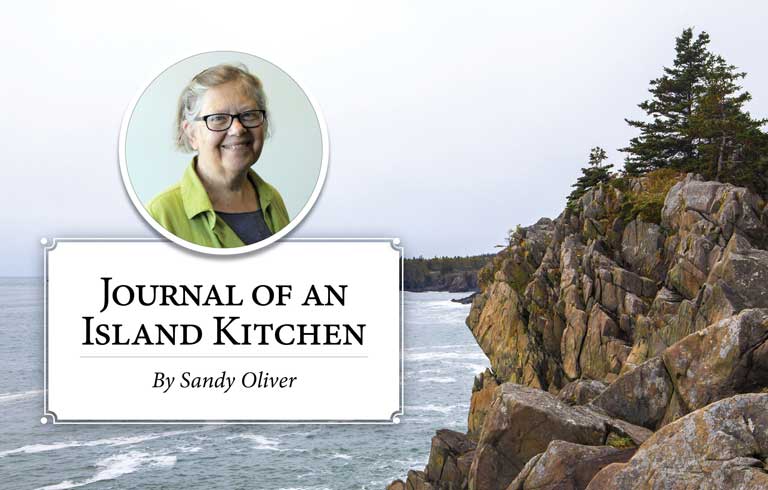Mussels used to grow nearby on rocks at the water’s edge, and now there aren’t many at all. And it was getting harder about 25 years ago, but we used to dig clams out of a tidal flat just down the road, enough for a meal of steamers. No more.
It’s a good thing this household doesn’t depend on foraged food to survive. Our taste, though, for mussels, clams, and oysters hasn’t diminished.
My niece stripped the last wild gathered mussels we had—fat, sweet, and pearl-free—off mooring lines when she worked for one of the boatyards. Those presaged the mussel aquaculture operation the same boatyard’s establishment created a short while ago in West Penobscot Bay.
Lots of us love those plump, round, white adductor muscles that most of us think of as scallops.
We can buy Josh and Shey Conover’s wonderful mussels from them directly or at an island market; a little easier than wading around, slipping on rockweed, but not as much fun in summer.
Meanwhile, close to Warren’s Island, Gene Cartright grows magnificent oysters, beloved raw by many, but not me.
So far, the canny know where to find clams, but of course, green crabs figured that out, too, and clams, over the past few decades, became pricey fare. A few years ago I counted the fried clams in a pint, divided the number into the price of the serving and calculated I spent $1.29 each. I think it was worth it.
Then there are scallops. In East Penobscot Bay, near Stonington, Marsden Brewer with his son, Bob, have established PenBay Farmed Scallops.
Lots of us love those plump, round, white adductor muscles that most of us think of as scallops. A kind of winter luxury, typically harvested from December to April, and shucked at sea; only the muscle is sold to cooks.
We read about diver-scallops, and the damage that scallop draggers cause to the ocean floors, and scallops, along with an awful lot of fish and shellfish, are regulated to avoid overfishing. So farm-raised scallops certainly look like a good alternative, or as Marsden diplomatically points out, a helpful and non-competitive addition to the scallop fishery. Besides, scallop farming offers some interesting culinary opportunities to boot.
Farm-raised scallops can be eaten whole, once you pinch out the little black digestive gland close to the adductor. Steamed, the mantle and gills curl into a frill around the muscle and add flavor.
Most of us aren’t used to the idea of a whole scallop and need guidance, so Marnie Crowell picked up the challenge and, working with professional chef Barton Seaver, assembled a how-to manual for cooking with them. Recipe Ideas for Farm Sea Scallops, The Whole Story (chuckle, chuckle) is full of beautiful pictures and narrative recipes—that is, instructions in sentence and paragraph form with embedded, instead of listed ingredient amounts. Accomplished cooks and professionals will appreciate the handbook; newer cooks might be challenged by the format.
Marnie included suggestions for how to cook various sized scallops from the tiny so-called princess, to the medium queens, and larger kings. Drawing on Mediterranean and Asian traditions with scallops, pairing them up with various cheeses, using pasta, or modifying other shellfish recipes to use scallops, Marnie’s recipe ideas were helpful as I worked my way through a generous assemblage of scallops Marsden kindly supplied me with.
I made stuffed scallops out of some of the largest, saving the adductor muscle for a favorite orzo, feta, and scallop dish. I chopped the steamed mantles with breadcrumbs and herbs and spices, then baked them. Gosh, they were good. Some of the whole smaller scallops made with a kind of Alfredo sauce on pasta turned out beautifully.
How to acquire Marnie’s manual? Order it on the PenBay Farmed Scallops website.
So far, the best way to acquire PenBay scallops is to pre-order them. Marsden writs: “Whole scallops are all pre-ordered and available at Glidden Point Oyster in Edgecomb and Gulf of Maine Sashimi in Portland. Both places can ship. People in Eastern Maine can pre-order from the growers by calling 367-5100 for pickup in Stonington.”
Until the pandemic struck, PenBay hoped for scallop sales to restaurants, but it became clear they needed as customers home cooks, too.
My bet? You’ll eat your first whole scallop when you dine out after COVID. You’ll like it a whole lot and will want to cook them at home. PenBay Farmed Scallops, and other emerging scallop farmers will gradually ramp up production and they won’t be a rarity anymore.
Sandy Oliver gardens, cooks, and writes on Islesboro.





